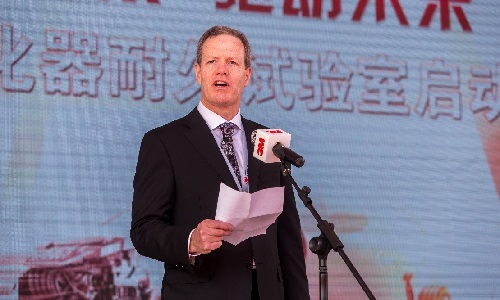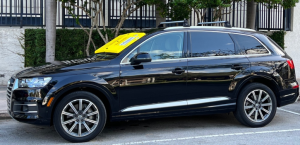By Jeff Sanford
Toronto, Ontario — March 20, 2018 — In this week’s Tuesday Ticker, AutoCanada reports that service and repair drive a big 2017, PPG lifts prices for auto OEMs, and much more.
AutoCanada
The publicly-traded Canadian automobile dealership group AutoCanada this week reported its financial results for full year and final quarter of 2017. The company enjoyed a solid ramp-up in business in the fourth quarter, pushing annual revenue over a new threshold of $3 billion. Earnings per share for 2017 came in at $2.11. On a conference call to announce the result the chief executive officer, Stephen Landry, discussed the company’s full year performance, which was positively influenced by record auto sales. “We had a very strong finish to the year continuing a trend that really started to take hold late in the second quarter of 2017. We were helped by a strong new vehicle market in Canada, in fact the new vehicle market hit or exceeded two million units for the first time in 2017. The market was particularly strong in Ontario and the western provinces and it provided us with a nice tailwind for three consecutive quarters in a row. We also hit three records in 2017. One was revenue $3.1 billion, up 16 percent from last year, [earnings of] $112 million up 11 percent from last year, and net earnings $57.8 million up 24 percent from 2016. And while reducing our operating expense marginally during the year,” said Landry. Over the year the company also added two new brands to the portfolio. In April, AutoCanada expanded its luxury portfolio with the addition of Mercedes-Benz Rive-Sud in Montreal and announced the first Mazda dealership in October. In December the company became the first publicly-traded one to sign what’s known as a public company master agreement (PCMA) with General Motors of Canada. PCMAs are the basic agreement signed between companies and individuals who may run an organization that uses the OEM’s brand. The 2017 PCMA with AutoCanada will see the company allowed to take a direct ownership stake in several GM Canada dealerships and voting control at those organizations for the first time in the history of the Canadian industry. According to Landry, “These agreements were a long time in the making and well worth the efforts. Now the acquisition of additional GM dealerships for AutoCanada is a very important part of our acquisition plan going forward.” Over the course of the year AutoCanada worked on diversifying its business across the country. AutoCAnada is a western-based company and it was hurt when the Alberta economy tanked in the wake of low oil prices. “The combination of new dealers in Montreal and our divestiture of GM dealerships in Edmonton and British Columbia shifts our geographical weight from the west and then also adds luxury and import brands in diversifying our product along with our domestic brands,” said Landry. All in, the organization sold 43,773 new vehicles in 2017. This is an increase of 9.3 percent over the year prior. New vehicles accounted for 58.9 percent of the company’s total revenue and 25.3 percent of gross profit. AutoCanada also operates several hundred service and collision repair bays that generate a large part of the organization’s profit. But the last half of 2017 was hot for auto sales. “In the fourth quarter, we sold 9,822 new vehicles posting an increase of 16.3 percent from the same quarter in 2016,” said Landry. Going on, he noted that used car sales accounted for 23 percent of the company’s annual total revenue, and 8.4 percent of gross profit, which is down slightly from 2016. But in the last quarter used vehicle sales were up 4.3 percent to 4,653 vehicles. AutoCanada also reported that annual revenue from parts, service and collision repair generated $416.7 million, which is up 8.8 percent from 2016. This section of the business is the big money-spinner for AutoCanada. In 2017 this business accounted for just 13.4 percent of total annual revenue but represents 41.3 percent of gross profit. Collision repair clearly pays. For the fourth quarter of 2017, “parts, service and collision repair revenues were $107.2 million or an increase of 16.1 percent from the same quarter last year. This was 14.6 percent of total revenue for the quarter and 45.5 percent of gross profit, slightly lower than in the fourth quarter of 2016,” said Landry. The other key business line, finance and insurance, generated revenue of $141.3 million up 8.6 percent from the year prior. “This was 4.6 percent of our total annual revenue and 25 percent of gross profit, both measures up from 2016. For the [fourth quarter of 2017] finance and insurance generated $33 million of revenue, an increase of 6.1 percent in the same quarter in 2016, which is 4.5 percent of our total revenue for the quarter and 24.5 percent of gross profit,” he said. In 2017 gross profit totalled $518.6 million, up 6.7 percent compared to the previous year. On a quarterly basis, gross profit was $125.2 million, up 7.2 percent compared with the same quarter in 2016. All of this is good news for shareholders, who enjoyed an increase in earnings attributable to AutoCanada shareholders of $111.8 million, or an 18 percent gain from the year prior. “In summary, 2017 was a good year and ended very well. That in turn helped deliver strong results across all segments of our business giving a reason to be confident about 2018,” said Landry. Executives at AutoCanada offered up a look at the year ahead during the conference call. “Early projections for 2018 indicate a continued strong Canadian market. The economy is doing well, interest rates continue to be low, albeit are expected to increase this year marginally. We are in a strong economy with low unemployment and for AutoCanada this provides a healthy macro environment. The preference for trucks and SUVs also bodes well for us given our current product mix,” he said. Discussing the company’s business model Landry said that new vehicle sales continue to be “our initial touch point with the customer.” From there, “we begin a long-term relationship with our customers through [finance and insurance], parts and service and when the customer comes back to trade in that vehicle for another new one and the cycle continues.” The company expects to continue its acquisition spree in the year ahead. “Acquiring new dealerships and effectively integrating them is key to our long term success. We are actively looking to replace the volume in net earnings from our recent GM divestitures through acquisitions of the same manufacturer as well as other brands. The acquisition pipeline remains quite strong and we continue to critically evaluate our opportunities which are both strategic and lucrative. Clustering our grouping strategy remains in place and we look forward to the addition of new stores in metropolitan areas. We think the auto industry is at a critical juncture. Some of the trends and innovations and disruptions will only accelerate in the years ahead. These are the trends driven by technology like electrification, artificial intelligence, driverless cars, advanced robotics and we embrace it at AutoCanada and we intend to play a significant role in the retail space as it does change over the next 10 years. This will allow us to adapt our business to the face of complex dynamics in a changing industry,” he said. After the presentation the call was opened up to questions from analysts. One asked whether the company was worried that auto sales of new cars are generally expected to peak this year in North America. When asked if AutoCanada can maintain its performance post sales-peak, Landry was adamant: “The short answer is yes. The two million vehicle market is to me, just a large sandbox that we play in. And for our new volume, which is the largest new volume in Canada for an auto retail group of 43,700 units, we still have a lot of runway and a lot of growth still to go. So even as the total industry sales of two million comes down to 1.9 million or even 1.8 million, we don’t need different levers although we have them. But the really nice balance of new and used is one, but the actual margin on new and used is somewhat limited. The real opportunity is in service and parts, we can develop increased and improved margins that could significantly benefit our bottom line.”
3M
3M recently named chief operating officer Michael Roman as its next chief executive. Current chief executive officer, Inge Thulin, will step down to become chairman of the board when Roman takes over as CEO in July, according to the Minnesota-based adhesive manufacturer.
PPG
PPG announced this past week it will raise prices for select coatings products for automotive OEM customers in the Americas. The price hike will be effective immediately or as contracts permit, according to a press release. Apparently, the company is taking the pricing actions to head-off the effect of rising raw material and operating costs. One report suggests PPG is, “currently witnessing excess demand for raw materials outpacing the supply capacity of industries providing materials for paints and coatings. Additionally, the company has seen increased freight and logistics costs for the past six months due to oil prices increasing nearly 40 percent over the past nine months.”
Magna
Major Canadian publicly-traded auto parts maker Magna announced this past week it will invest $200 million into a production facility to produce self-driving car parts. The deal is a partnership with ride-sharing firm Lyft. The two companies have signed a “multi-year partnership to develop self-driving systems,” according to executives speaking at a press conference. The autonomous vehicles that Lyft and Magna will be working together to build will be Level 4, that is, “they will be able to operate without any human intervention within the car’s normal operating parameters.”





































